Plot summary
The recurring team of Powell and Donovan are testing a new model of robot on an asteroid mining station. This DV-5 (Dave) has six subsidiary robots, described as "fingers", which it controls via positronic fields, a means of transmission not yet fully understood by roboticists. When the humans are not in contact, the robot stops producing ore. It cannot recall the time periods when it stops mining, and states that it finds this just as puzzling as the humans do.
Powell and Donovan secretly observe the robot without its knowledge. It starts performing strange marches and dances with its subsidiaries whenever something unexpected happens—an early example of a Heisenbug (software problem). To learn more, the humans try to create an emergency situation around the robot in order to observe the precise moment of malfunction, but accidentally trap themselves in a cave-in. They eventually figure that the main robot has too many subsidiaries. The "fingers" function independently until there is a serious need of decisiveness, when the main brain has to assume 6-way-control of all "fingers", which requires an excess of initiative and causes overload. When the humans were watching, their presence reduced the initiative placed on the robot's mind, and it would not break down. To get themselves rescued, the humans shoot and destroy one of the subsidiaries. The main robotic brain can cope with five-way control, hence the robots stop dancing and the First Law takes over.
Powell anthropomorphises the error as the robot twiddling its "fingers" whenever it becomes overwhelmed by its job. This is another example of Asimov's writing of robopsychology—personified by Susan Calvin—as running parallel to human psychology. At this point in I, Robot, the reader has already seen hysteria and religious mania.
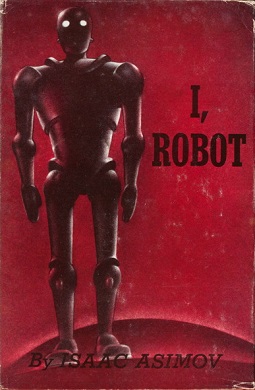
I, Robot is a fixup collection made up of science fiction short stories by American writer Isaac Asimov. The stories originally appeared in the American magazines Super Science Stories and Astounding Science Fiction between 1940 and 1950 and were then collected into a 1950 publication Gnome Press in 1950, in an initial edition of 5,000 copies.

Isaac Asimov was an American writer and professor of biochemistry at Boston University. During his lifetime, Asimov was considered one of the "Big Three" science fiction writers, along with Robert A. Heinlein and Arthur C. Clarke. A prolific writer, he wrote or edited more than 500 books. He also wrote an estimated 90,000 letters and postcards. Best known for his hard science fiction, Asimov also wrote mysteries and fantasy, as well as much popular science and other non-fiction.

A robot is a machine—especially one programmable by a computer—capable of carrying out a complex series of actions automatically. A robot can be guided by an external control device, or the control may be embedded within. Robots may be constructed to evoke human form, but most robots are task-performing machines, designed with an emphasis on stark functionality, rather than expressive aesthetics.
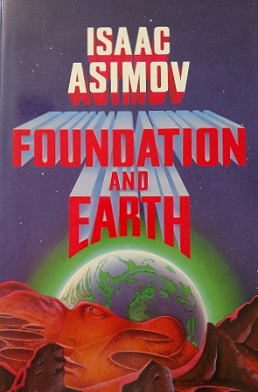
Foundation and Earth is a science fiction novel by American writer Isaac Asimov, the fifth novel of the Foundation series and chronologically the last in the series. It was published in 1986, four years after the first sequel to the Foundation trilogy, which is titled Foundation's Edge.

The Three Laws of Robotics are a set of rules devised by science fiction author Isaac Asimov, which were to be followed by robots in several of his stories. The rules were introduced in his 1942 short story "Runaround", although similar restrictions had been implied in earlier stories.

Nemesis is a science fiction novel by American writer Isaac Asimov. One of his later science fiction novels, it was published in 1989, three years before his death. The novel is loosely related to the future history of his Robot Series, Empire Series, and Foundation Series, into which Asimov attempted to integrate his science fiction output. This novel is connected to Asimov's other works by several ideas from earlier and later novels, including non-human intelligence, sentient astronomical bodies ("Hallucination"), and rotor engines.
A positronic brain is a fictional technological device, originally conceived by science fiction writer Isaac Asimov. It functions as a central processing unit (CPU) for robots, and, in some unspecified way, provides them with a form of consciousness recognizable to humans. When Asimov wrote his first robot stories in 1939 and 1940, the positron was a newly discovered particle, and so the buzz word "positronic" added a scientific connotation to the concept. Asimov's 1942 short story "Runaround" elaborates his fictional Three Laws of Robotics, which are ingrained in the positronic brains of nearly all of his robots.
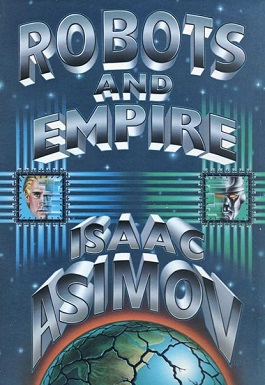
Robots and Empire is a science fiction novel by the American author Isaac Asimov, published by Doubleday Books in 1985. It is part of Asimov's Robot series, which consists of many short stories and five novels.

A gynoid, or fembot, is a feminine humanoid robot. Gynoids appear widely in science fiction film and art. As more realistic humanoid robot design becomes technologically possible, they are also emerging in real-life robot design. Just like any other robot, the main parts of a Gynoid include sensors, actuators and a control system. Sensors are responsible for detecting the changes in the environment while the actuators, also called effectors, are motors and other components responsible for the movement and control of the robot. The control system instructs the robot on what to do so as to achieve the desired results.

Foundation and Chaos (1998) is a science fiction novel by Greg Bear, set in Isaac Asimov's Foundation universe. It is the second book of the Second Foundation trilogy, which was written after Asimov's death by three authors, authorized by the Asimov estate.
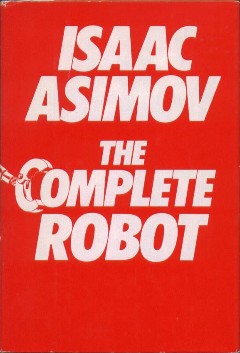
The Complete Robot (1982) is a collection of 31 of the 37 science fiction short stories about robots by American writer Isaac Asimov, written between 1939 and 1977. Most of the stories had been previously collected in the books I, Robot and The Rest of the Robots, while four had previously been uncollected and the rest had been scattered across five other anthologies. They share a theme of the interaction of humans, robots and morality, and put together tell a larger story of Asimov's fictional history of robotics. The stories are grouped into categories.
"Runaround" is a science fiction short story by American writer Isaac Asimov, featuring his recurring characters Powell and Donovan. It was written in October 1941 and first published in the March 1942 issue of Astounding Science Fiction. It appears in the collections I, Robot (1950), The Complete Robot (1982), and Robot Visions (1990). "Runaround" features the first explicit appearance of the Three Laws of Robotics, which had previously only been implied in Asimov's robot stories.
"Reason" is a science fiction short story by American writer Isaac Asimov, first published in the April 1941 issue of Astounding Science Fiction and collected in I, Robot (1950), The Complete Robot (1982), and Robot Visions (1990). It is part of Asimov's Robot series, and was the second of Asimov's positronic robot stories to see publication.
"Escape!" is a science fiction short story by American writer Isaac Asimov. It was first published as "Paradoxical Escape" in the August 1945 issue of Astounding Science Fiction and reprinted as "Escape!" in the collections I, Robot (1950) and The Complete Robot (1982).

I, Robot is a 2004 American science fiction action film directed by Alex Proyas. The screenplay by Jeff Vintar and Akiva Goldsman is from a screen story by Vintar, based on his original screenplay Hardwired, and named after Isaac Asimov's 1950 short-story collection. The film stars Will Smith in the main role, Bridget Moynahan, Bruce Greenwood, James Cromwell, Chi McBride, and Alan Tudyk. Set in Chicago in 2035, highly intelligent robots fill public service positions throughout the world, operating under three laws to keep humans safe. Detective Woody Spooner (Smith) investigates the alleged suicide of U.S. Robotics founder Alfred Lanning (Cromwell) and believes that a human-like robot called Sonny (Tudyk) murdered him.
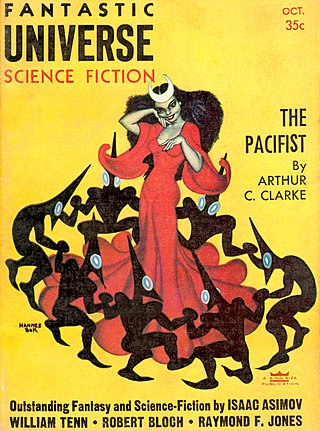
"First Law" is a science fiction short story by American writer Isaac Asimov, first published in the October 1956 issue of Fantastic Universe magazine and later collected in The Rest of the Robots (1964) and The Complete Robot (1982). The title of the story is a reference to the first of the Three Laws of Robotics.
"Risk" is a science fiction short story by American writer Isaac Asimov, first published in the May 1955 issue of Astounding Science Fiction, and reprinted in the collections The Rest of the Robots (1964) and The Complete Robot (1982).
"Lenny" is a science fiction short story by American writer Isaac Asimov, originally published in the January 1958 issue of Infinity Science Fiction, and included in the collections The Rest of the Robots (1964), The Complete Robot (1982), and Robot Visions (1990).
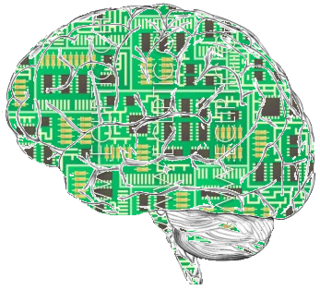
Mind uploading, whole brain emulation, or substrate-independent minds, is a use of a computer or another substrate as an emulated human brain. The term "mind transfer" also refers to a hypothetical transfer of a mind from one biological brain to another. Uploaded minds and societies of minds, often in simulated realities, are recurring themes in science-fiction novels and films since the 1950s.












